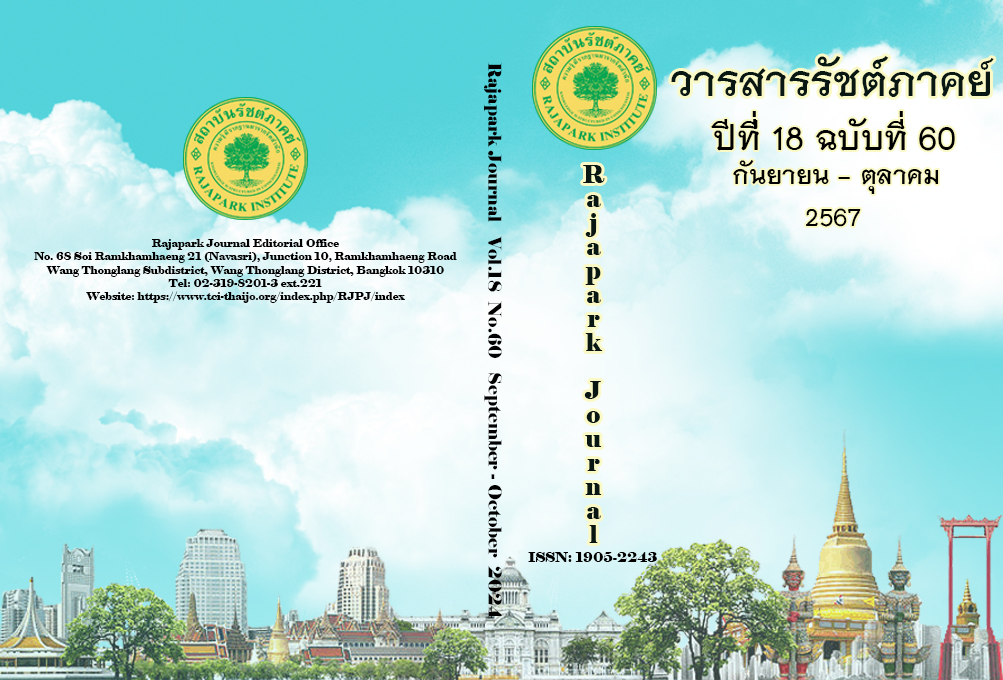The Development Guidelines for the Herbal Health Tourism Learning Resources Based on the Bio-economy in Rong Chang Sub-district, Pa Daet District, Chiang Rai Province
Main Article Content
Abstract
This research aimed to 1) analyze the potential of herbal health tourism learning resources, 2) design and develop herbal health tourism learning resources, and 3) recommend the guidelines for developing herbal health tourism learning resources based on the bio-economy in Rong Chang Sub-district, Pa Daet District, Chiang Rai Province. This research is qualitative. The sample was 25 tourism stakeholders who were selected by purposive sampling. The instruments for collecting data were in-depth interviews and focus group discussions. Analysis of data was conducted by content analysis. The research results were found as follows: 1) Rong Chang Sub-district has the potential to be a learning resource, including herbal health tourism with suitable natural tourism attractions, an inheritor of herbal knowledge according to the Mon Ya area in Rong Chang for local treatment, documents of herbal therapy, and herbal knowledge according to the four elements (earth, water, wind, and fire) in the Rong Chang Sub-district. 2) The project plan for the herbal health tourism learning resources covers 25 types of herbs designed by the participation of the community, including the project plan, the entrance plan with a tree tunnel, earth element herbal zone plan, water element herbal zone plan, wind element herbal zone plan, and fire element herbal zone plan. These plans consider the aesthetics and rarity of the herbs. 3) The research recommended the seven guidelines for the development of herbal health tourism learning resources, including (1) inheriting the identity of community herbs, (2) managing herbal zones, (3) innovators of herbal health tourism, (4) herbal health products and services, (5) creating herbal health tourism activities, (6) management of health tourism attractions, and (7) participation.
Article Details

This work is licensed under a Creative Commons Attribution-NonCommercial-NoDerivatives 4.0 International License.
Views and opinions appearing in the Journal it is the responsibility of the author of the article, and does not constitute the view and responsibility of the editorial team.
References
Balsiri, N. (2020). The participatory management of cultural learning resources to enhance community identity base on creative economy and local wisdom (Research report). Dhonburi Rajabhat University. https://cms.dru.ac.th/jspui/handle/123456789/1828
Chirakitnimit, N., Chetiyanukornkul, T., & Sandthong, S. (2023). Honest livelihood: Knowledge of local medicinal plants and connection management for sustainable development in Doi Langka. Journal of MCU Peace Studies, 11(4), 1549-1561. https://so03.tci-thaijo.org /index.php/journal-peace/article/view/265795
Global Wellness Institute. (2023). Wellness economy statistics & facts. https://globalwellnessinstitute.org/press-room/statistics-and-facts
Jaima, W., Charoensup, R., Duangyod, T., & Leetrakul, P. (2020). Development of herbal based health tourism in Chiang Rai province for tourist from Republic of the Union of Myanmar, People’s Republic of China, Lao People’s Democratic Republic, and Kingdom of Thailand (MCLT) (Research report). Thailand Science Research and Innovation (TSRI). https://digital.library.tu.ac.th/tu_dc/frontend/Info/item/dc:182771
Klindeephi, J. (1998). Evaluation of the potential of tourism attractions for ecotourism. Case study: Sai Yok National Park, Dangakan Chanaburi[Master’s thesis, National Institute of Development Administration].
Ministry of Higher Education, Science, Research and Innovation. (2019). BCG in action proposal: The new sustainable growth engine, economic model for sustainable development. https://www.nxpo.or.th/th/bcg-economy
Ministry of Tourism and Sports. (2022). Strategic plan for driving white tourism. Under the BCG economic model 2023-2027. https://www.mots.go.th
Ministry of Tourism and Sports. (2023). Thailand’s National Tourism Development Plan No. 3 (2023 – 2027). https://secretary.mots.go.th/ewtadmin/ewt/secretary/download/article/article_20230327145011.pdf
Nipo, D. T., Chan, J. K. L., & Saikim, F. H. (2021). Exploring the potential of herbal tourism in sabah: A case of DAI-C-RECREATION CENTRE, Kiulu. BIMP-EAGA Journal for Sustainable Tourism Development, 10(1), 1-10. DOI: 10.51200/bimpeagajtsd.v10i1.3387
Sarobon, S. (2013). Biological-based economy: A body of knowledge and community-based management in the upper northern of Thailand (Research report). Maejo University.
Srirathu, V. (2008). Eco-tourism potential of Amphoe Khao Kho, Phetchabun Province[Master’s thesis, Srinakharinwirot University].
Torabi Farsani, N., Zeinali, H., & Moaiednia, M. (2018). Food heritage and promoting herbal medicine-based niche tourism in Isfahan, Iran. Journal of Heritage Tourism, 13(1), 1-11. DOI: 10.1080/1743873X.2016.1263307
Tourism Authority of Thailand. (2021). 9 New trends in the future of tourism. https://api.tourismthailand.org/upload/live/content_article_file/20603-15378.pdf
Widarini, P. S. I., & Wijaya, M. (2022). Wellness and herbal tourism based on local wisdom as an alternative to ‘New Normal’ tourism. Jurnal Komunikasi, 14(2), 299-321. DOI: 10.24912/jk.v14i2.17568
Yimsrual, S. (2018). Tourism facilities and landscape design guideline for natural hot spring tourist attraction. Journal of Environtmental Design, 5(2), 101-129. https://so02.tci-thaijo.org/index.php/jed/article/view/203345


